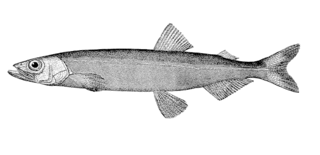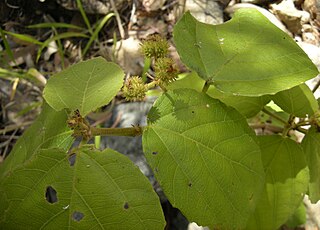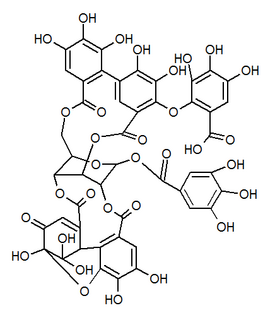
The capelin or caplin is a small forage fish of the smelt family found in the North Atlantic, North Pacific, and Arctic oceans. In summer, it grazes on dense swarms of plankton at the edge of the ice shelf. Larger capelin also eat a great deal of krill and other crustaceans. Among others, whales, seals, Atlantic cod, Atlantic mackerel, squid, and seabirds prey on capelin, in particular during the spawning season while the capelin migrate south. Capelin spawn on sand and gravel bottoms or sandy beaches at the age of two to six years. When spawning on beaches, capelin have an extremely high post-spawning mortality rate which, for males, is close to 100%. Males reach 20 cm (8 in) in length, while females are up to 25.2 cm (10 in) long. They are olive-colored dorsally, shading to silver on sides. Males have a translucent ridge on both sides of their bodies. The ventral aspects of the males iridesce reddish at the time of spawn.

Mallotus is a genus of the spurge family Euphorbiaceae first described as a genus in 1790. Two species are found in tropical Africa and Madagascar. All the other species are found in East Asia, the Indian Subcontinent, Southeast Asia, eastern Australia, and certain islands of the western Pacific. The genus has about 150 species of dioecious trees or shrubs.
Hancea is a genus of plants in the family Euphorbiaceae. Species include Hancea integrifolia.

Chrozophora is a plant genus of the family Euphorbiaceae first described as a genus in 1824. It comprises monoecious herbs or undershrubs. The genus is widespread across Europe, Africa, and Asia.
Mallotus atrovirens is a species of plant in the family Euphorbiaceae. It is endemic to Tamil Nadu in India.
Mallotus fuscescens is a species of plant in the family Euphorbiaceae. It is endemic to Sri Lanka.
Mallotus odoratus is a species of plant in the family Euphorbiaceae. It is endemic to the Philippines.

Mallotus philippensis is a plant in the spurge family. It is known as the kamala tree or red kamala or kumkum tree, due to the fruit covering, which produces a red dye. However, it must be distinguished from kamala meaning "lotus" in many Indian languages, an unrelated plant, flower, and sometimes metonymic spiritual or artistic concept. Mallotus philippensis has many other local names. This kamala often appears in rainforest margins. Or in disturbed areas free from fire, in moderate to high rainfall areas.

Mallotus claoxyloides is an Australian rainforest plant in the spurge family. Common names include green kamala, odour bush, and smell of the bush. Opinions are divided on the strong scent of the plant. Some say it is offensive and resembles a skunk while most others find the scent aromatic and delightful. Because of the scent, it is grown in gardens.

Mallotus ficifolius is a shrub of the spurge family Euphorbiaceae endemic to Northern and Central Queensland, Australia. The species is commonly called fig leafed mallotus
Mallotus oppositifolius is a plant species in the genus Mallotus found in Africa and Madagascar.

Mallotus japonicus, also known as East Asian mallotus, the food wrapper plant or "Akamegashiwa" in Japanese, is a plant species in the genus Mallotus native to China. It is also found in Japan and Korea. This species was first described in 1865, its name was verified by AAS Systematic Botanists on October 2, 2015.

Mallotusinic acid is a hydrolysable tannin found in the bark of Mallotus japonicus. It is more generally present in Geraniales.
Mallotus eriocarpus is a species of plant in the family Euphorbiaceae. It is endemic to Sri Lanka.
Mallotus distans is a species of plant in the family Euphorbiaceae. It is native to South India and Sri Lanka.
Mallotus resinosus, the resinous kamala , is a species of 12m tall shrub, evergreen plant in the family Euphorbiaceae. It is native to India, Sri Lanka to New Guinea and Australia. The plant is known as "கருவாளிச்சீ / karuvalichchi" by Tamil people.

Mallotus mollissimus is a rainforest plant in the spurge family. Indigenous to Queensland and Malesia.

The climbing liana, sometimes a shrub, Mallotus repandus, is a species of plant in the Euphorbiaceae, or spurge, family. It is native to Tropical and Sub-tropical Asia, Wallacea, New Guinea and Queensland on the Australian continent and New Caledonia.
Mallotus plicatus is a tree or shrub in the Euphorbiaceae family, in the Polyadenii section. It occurs in much of Mainland Southeast Asia. It is used for dyeing and in construction.








